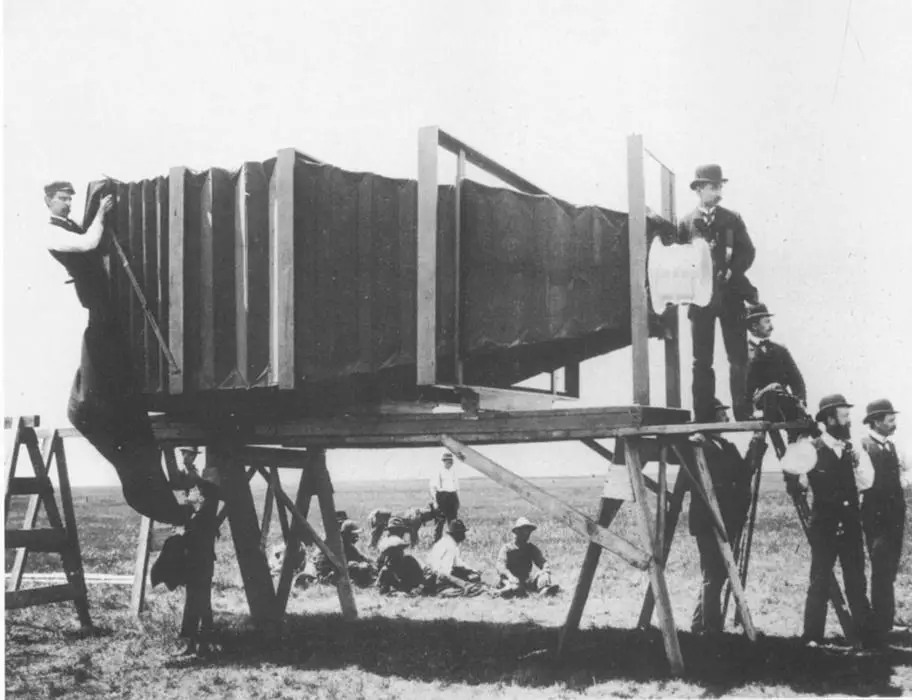George R. Lawrence was an innovative photographer in the late 1800s who designed the world’s largest camera to take the largest panoramic photograph possible of a new and exquisite train called the Alton Limited. The huge camera was known as the Mammoth Camera.
Lawrence had already become known for his innovative flash photography technique and was a pioneer in aerial photography before designing the Mammoth Camera. His new techniques with aerial photography included using telescoping towers, and later, a custom-designed, gas-filled, hot-air balloon, in which he would ride up in the sky to take photographs of cities from a bird’s eye perspective. He soon used kites to achieve the same effect.
In 1899, the Chicago and Alton Railroad began running a route from Chicago, Illinois, to St. Louis, Missouri. They used a train called the Alton Limited that was specifically designed for the route. It was a customized train that was considered the finest train ever built, consisting of six Pullman cars at the same height and length and a coal tender and engine in the same design as the cars. The company considered it “the Handsomest train in the World.”
The railroad wanted an eight-foot-long photograph of the entire train, all in one picture, to show off their new train in their advertising and to be witnessed at the Paris Exposition of 1900. George Lawrence was asked to take on the challenge of taking the huge photo.
He initially proposed to take a picture of the train in sections and then piece them together, but the railroad company insisted on having only one single picture of their entire train. Lawrence knew he had to design and build a very large camera to complete the task.
Lawrence supervised the building of the camera by camera manufacturer J. A. Anderson. When it was completed, it weighed 1,400 pounds, with the camera coming in at 900 pounds and the plate holder at 500 pounds. The Mammoth Camera had a glass negative that was 8 feet by 4.5 feet with Carl Zeiss patented lenses, one wide-angle and one telescopic rectilinear lens, made by the Bausch and Lomb Optical Company of Rochester, NY.
The bellows of the camera were supported by wooden pieces and covered in three layers: an outer heavy rubber cover, a black canvas lining, and another opaque black material. Around 40 gallons of glue was used to secure all the pieces together. The camera cost $5,000 to build, or about $154,000 in today’s dollars adjusted for inflation, and it was completed in two and a half months.
In the Spring of 1900, it became time to move the new camera. It took 15 men to load it on a van which then took the camera to the Chicago and Alton Railway Station. It was loaded on a flat rail car and moved six miles from the city to Brighton Park. It was then offloaded and carried a fourth of a mile to an open field, where it was set up under the supervision of Lawrence and pointed at the Alton Limited, which sat on the tracks in the distance.
After the camera was properly set up, Lawrence and the workers began to take the picture, which required an exposure time of two and a half minutes. He got a perfect shot and negative of the Alton Limited to make the huge, one-time picture, satisfying the request of the railroad company.

Three copies were made of the giant photograph, and these were submitted to the 1900 Paris Exposition. George Lawrence won the prize for World Photographic Excellence, but some questioned whether the huge photo was real due to its clarity and size and that it came from only one camera. Lawrence and the railroad had to submit affidavits verifying its authenticity and that it was indeed from a single camera.
The Mammoth Camera was used by Lawrence a few more times. One shot he took was a huge group photograph where each person’s facial expressions could be clearly seen. Lawrence eventually moved away from photography by the late 1910s and began to delve into aviation design after his pioneering contributions to photography.
Sources: Taylor and Francis Online, STSTW Media, Robroy


